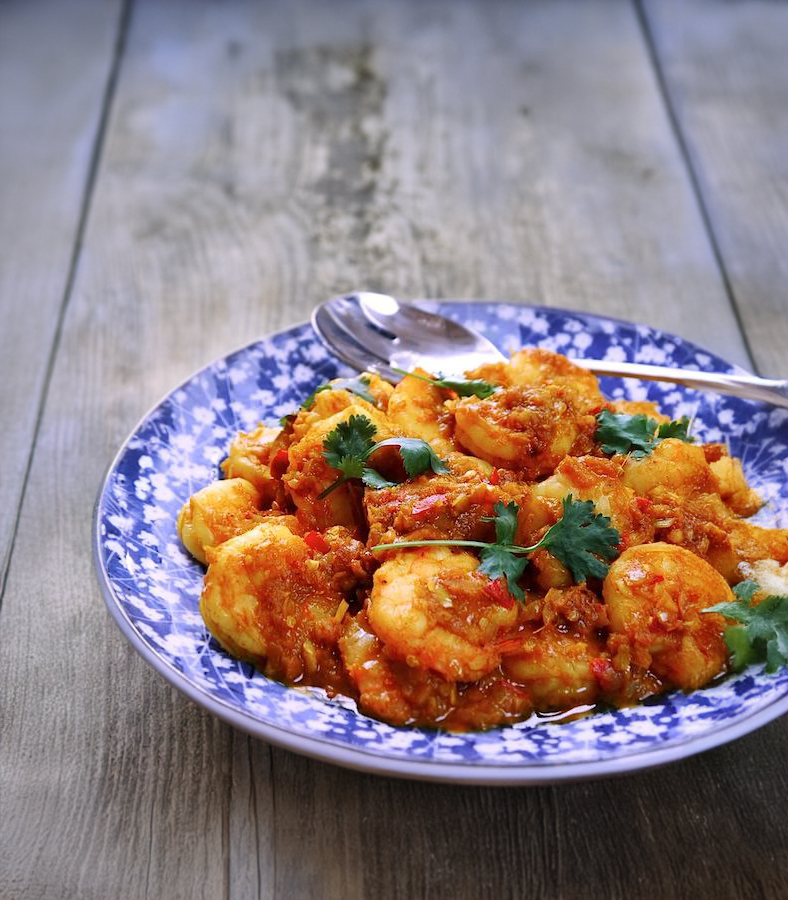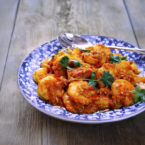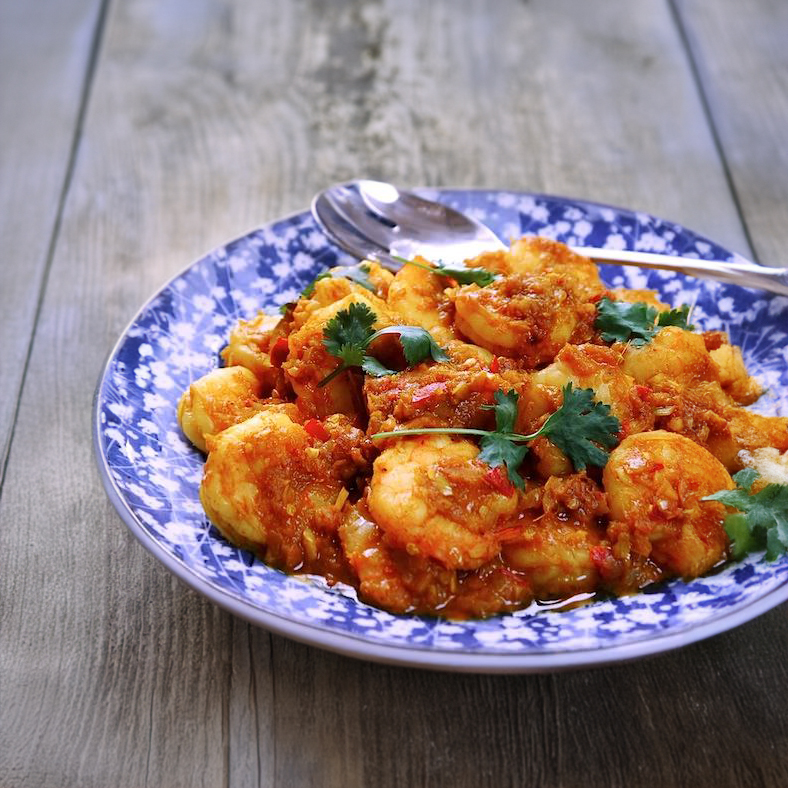I do love a spicy seafood dish.
This recipe – Malaysian Sambal Udang (Prawn Sambal) – was created by my paternal Grandmother (my popo) and pieced together painstakingly by my cousin Carina. I’ve adapted it further, as the ingredients are a little different where I live, to recreate the taste I remembered.
I only have my memory to guide me as my grandmother passed away a few years ago. She was 93 when she died and had lived a long and full life, with mostly good health. She left behind four children, eight grandchildren, seven great-grand children, and a wealth of memories and recipes.
My grandmother was an excellent and thoughtful cook. Every time we visited Malaysia we would be treated with a smorgasbord of our favorite foods – fried chicken, sambal hebi (dried shrimp sambal), fish head curry, Penang Asam laksa, pineapple fried rice, yong tofu (stuffed beancurd), water spinach fried with sambal belchan, and fried eggplants stuffed with minced prawn.
It was completely excessive but cooking was her way of demonstrating her love. It’s something my dad learned from her, and something I in turn picked up from my parents.
When I surprised them with this dish last week the look on their faces said it all.
“You’ve just gone to the top of the class,” my dad declared, as he hugged me.
“It’s just like I remember it,” smiled my mum.
Thanks, folks. That’s high praise indeed, but I’m just passing on the love.

How to Make Sambal Udang – Malaysian Prawn Sambal
1. Prepare the Spice Paste
- Chop and Blend: In a food processor, combine the onions, garlic, lemongrass, and Bird’s Eye chilies. Process until finely diced. Note: Use 2 chilies for mild-medium heat, 4 for hot, and 5 for extra hot.
2. Cook the Spice Paste
- Heat the Wok: Heat a wok over high heat until smoking.
- Add Oil and Paste: Add the vegetable oil, heat for a few seconds until shimmering, then add the processed spice mixture and belacan.
- Fry the Paste: Fry over medium heat, stirring continuously, until fragrant and the mixture starts to ‘split’ (about 3-5 minutes).
3. Add the Spices and Prawns
- Turmeric and Prawns: Add the ground turmeric and fry for another minute, stirring briskly. Then, add the prawns and the 1/3 cup of just boiled water.
- Stir to Combine: Stir to combine, ensuring the prawns are well coated with the spice mixture.
4. Season and Cook Through
- Add Seasonings: Add the tamarind concentrate, sugar, salt, and light soy sauce. Continue stirring until the prawns are pink and cooked through (about 3-5 minutes).
5. Serve
- Plate and Serve: Serve the Sambal Udang hot with steamed rice and fried Chinese vegetables.
Recipe Notes
- Belacan Substitute: If you cannot find belacan, you can substitute with a small amount of fish sauce or anchovy paste.
- Tamarind Concentrate: Available in Asian grocery stores; if unavailable, you can substitute with lemon juice mixed with a little sugar.
- Bird’s Eye Chilies: Adjust the amount to your heat preference.
- Wok Substitute: If you don’t have a wok, use a large frying pan.

My Grandmother’s Sambal Udang – Malaysian Prawn Sambal
- Total Time: 35 minutes
- Yield: 4 1x
Description
A treasured secret family recipe, recreated with love by the next generation. This fiery and vibrant prawn sambal is a delicious celebration of a Malaysian grandmother.
Ingredients
- 3 medium onions, peeled and roughly chopped
- 4 cloves garlic, peeled
- 2 lemongrass stalks, white part only, roughly chopped
- 2-5 Bird's Eye chilies
- 1 tbsp belacan (fermented shrimp paste)
- 2 tbsp vegetable oil
- 1/2 tsp ground turmeric
- 500 grams (18 ounces) raw, peeled prawns (shrimp)
- 1/3 cup water, just boiled
- 3 tbsp tamarind concentrate
- 2 tsp sugar
- 1/2 tsp salt
- 2 tsp light soy sauce
Instructions
1. Prepare the Spice Paste
- Chop and Blend: In a food processor, combine the onions, garlic, lemongrass, and Bird’s Eye chilies. Process until finely diced. Note: Use 2 chilies for mild-medium heat, 4 for hot, and 5 for extra hot.
2. Cook the Spice Paste
- Heat the Wok: Heat a wok over high heat until smoking.
- Add Oil and Paste: Add the vegetable oil, heat for a few seconds until shimmering, then add the processed spice mixture and belacan.
- Fry the Paste: Fry over medium heat, stirring continuously, until fragrant and the mixture starts to ‘split’ (about 3-5 minutes).
3. Add the Spices and Prawns
- Turmeric and Prawns: Add the ground turmeric and fry for another minute, stirring briskly. Then, add the prawns and the 1/3 cup of just boiled water.
- Stir to Combine: Stir to combine, ensuring the prawns are well coated with the spice mixture.
4. Season and Cook Through
- Add Seasonings: Add the tamarind concentrate, sugar, salt, and light soy sauce. Continue stirring until the prawns are pink and cooked through (about 3-5 minutes).
5. Serve
- Plate and Serve: Serve the Sambal Udang hot with steamed rice and fried Chinese vegetables.
Notes
- Belacan Substitute: If you cannot find belacan, you can substitute with a small amount of fish sauce or anchovy paste.
- Tamarind Concentrate: Available in Asian grocery stores; if unavailable, you can substitute with lemon juice mixed with a little sugar.
- Bird’s Eye Chilies: Adjust the amount to your heat preference.
- Wok Substitute: If you don’t have a wok, use a large frying pan.
- Prep Time: 15 mins
- Cook Time: 20 mins
- Category: Main Course
- Method: Stir Frying
- Cuisine: Malaysian
Nutrition
- Serving Size: 200g
- Calories: 220
- Sugar: 6g
- Sodium: 540mg
- Fat: 14g
- Saturated Fat: 2g
- Unsaturated Fat: 10g
- Trans Fat: 0g
- Carbohydrates: 10g
- Fiber: 2g
- Protein: 15g
- Cholesterol: 110mg















Thanks for sharing the recipe. How much prawns do we use for one serving? (good for 4)
Hey Kim, great question.
The recipe is written to serve 4, and it calls for 500 grams (about 1.1 pounds) of prawns. So for one serving, that’s roughly 125 grams (about 4.5 ounces) of peeled prawns per person.
If you’re using smaller prawns or planning to serve it with rice and a few side dishes, that amount is usually spot on. If it’s the main protein on the plate, you could bump it up slightly depending on appetite.
I tried your recipe and the Sambal had a strangely bitter aftertaste. I didn’t use chilli padi because the children cannot take spice; so I used a few rehydrated dried chillis to give me the red color. Do u think the bitterness could have come from the seeds of the chilli? I find it so baffling; because I’ve never encountered this b4; and I’ve done my fair share of sambals.
Hi Diane!
Sorry to hear about the bitter after taste! That sucks! It sounds like the bitterness likely came from the dried chilies. Their seeds and soaking water can carry a bitter taste, so I’d recommend removing the seeds before rehydrating and discarding the soaking liquid. Also, if they were toasted, even slightly overdoing it can add bitterness. Since the original recipe uses fresh Bird’s Eye chilies, switching to a milder fresh chili (like red Fresno or a small amount of red bell pepper) might be a better alternative for kids while keeping the sambal’s natural sweetness. Hope this helps, and I’d love to hear how your next batch turns out, should you give it another go.
Thank you for your question, we always want to make sure our readers are getting a great food experience!
This was really delicious, made mine a little too spicy, but the flavors were fantastic!
Really good, would love some more spice.
Tried this recipe today and it turned out fantastic! The flavors are just right. Your grandmother must have been an incredible cook.
Reading about your grandmother’s cooking made me nostalgic. Tried the recipe, and it was just like the sambal I remember from my childhood.
Damn, this sambal udang is spicy and delicious! Thanks for sharing your popo’s recipe. It’s a keeper.
This dish is absolute fire! Loved every bite. The story about your family really touched me. Keep those recipes coming!
Really delicious, looked beautiful too!
Wow I was overwhelming surprised to see just the same recipe my late mom used to dish up her sambal udang, except I don’t remember any soy sauce was added while cooking the dish. We did drizzle some soy sauce as individual preference when we eat. My mom would pound finely with mortar than chopping the shallots and other ingredients on the recipe. I remembered she was generous with the shallots in the recipe. Sometimes she would cook with added fresh pineapple cubes.
Christina, thank you for your sharing.
Thank you for this – Loved this recipe! Mine Didn’t turn red, but it Was so deliciously peranakan home made. Plse put together a cookbook!
I love so much to try out this recipe, but my husband has yet to acquire the taste and smell of belacan. Is it ok I omit the belacan, and what changes do I need to make this work? Thanks!
You can use either a small amount of anchovy paste or fish sauce.
Loved it! I am. French Chef and this one is a winner. I didn’t have tamarind and even without it was amazingly flavorful. I wonder if with chicken breast or fish will be as siccessful. It seems as if prawns are the ideal protein. Thank you
Chef, it will absolutely work for other proteins too!!
That was a very tasteful recipe. My birthday is almost at the door so I will prepare this prawn recipe for my children when they visit me for lunch, thank you Christine for you sharing this with us. Bye for now , Mary
[email protected]
This dish is incredible!
I followed the recipe exactly but 3 tablespoons of tamarind concentrate is a huge amount. Is tamarind concentrate different in australia to the uk?
Hi, Caroline
I haven’t tried any UK tamarind concentrates so unfortunately I can’t really say. But this could be possible. Other people seemed to have made it successfully so perhaps it was some kind of issue with the tamarind you used. Anyway, sorry it didn’t work out for you.
Glad to hear you enjoyed it! :D
I cooked this prawn sambal and it turned out very good. I have tried so many times from other recipes and yours is the best. Thanks for sharing! Instead of fresh lemon grass, I used the paste and I add more sugar. It was fantastic!
Wai Ling/ San Diego
Hi Christina,
The dish looks really good. Will be trying this tonight and thanks for the recipe. In the meantime, I think it’s called belacan instead of belcehan. My late grandma made the best belacan but unfortunately, I didn’t have the chance to learn it and the art was lost. In any case, I’ll post the verdict tomorrow as I’m making it for chap goh mei dinner tonight. Gong Xi Fa Chai to you and family!
how to prepare that belcehan shrimp paste at home?
This recipe uses purchased belcehan :)
So glad you liked it! :)
this is my favorite prawn recipe ever! And it works so well!
@HT
Thank you so much for your lovely feedback – I’m so touched my post reminded you of those special meals you had in Malaysia.
Cooking = sharing the love.
One early morning, 25 years ago, I arrived at Kuala Lumper via the night train from Singapore with a group of friends. My friend’s father picked us up from the train station, and when we arrived at his home, his grandmother had prepared a sumptious buffet of prawn noodles and other local favourites. She had spent the whole night doing this, sacrificing her sleep. 3 years later, another friend’s godmother, a kind Nyonya grandmother, prepared an amazing spread of Nyonya dishes, layed out beautifully on a long table. It took her three full days to prepare everything from scratch, with the help of her lovely Filipino domestic helper, whom she treated as a daughter. Your post brought back beautiful memories of these kind grandmothers, whose love for their families was extended to strangers such as me, through food.
<3
Hi Linda, I’m so glad you liked it! Thanks for taking the time to comment and let me know :)
Thanks Christina i had just tried the recipe it’s really nice and my husband. Love it
Hi Amanda, I’m sorry, I don’t remember the name of the belechan I use -only the packet (it is a bar). It’s one available at a lot of Adelaide Asian grocers so you should be able to find it.
Christine, what brand of belcehan do you recommend using.I live in Adelaide as well so if you point me the location that will be really helpfulThanks for sharing.Amanda
Hi Selaine
Thank you for sharing your recipe – I love the sound of it! And that Jasmine Fragrant Pandan rice sounds incredible, too
Best wishes
Christina
I’d like to express my sincerity thank you for sharing this recipe. It must be very delicious as I see the recipes. It’s my pleasure to suggest and it’s my personal opinion only from 10 years of cooking experience.If may suggest to mince garlic, Indian shallot, Bentong Ginger, minced lemongrass and eye bird chillies in a traditional way. When the oil starts simmer, add mince garlic, Indian Shallot, Bentong Ginger and cook till you may smell the aroma. Then, add lemongrass and eye bird chillies. Stir fry all the ingredients till aromatic, and add prawns and stir fry. After that, mix tamarind juice with a small teaspoon of brown sugar. Then, add altogether and cook about 10 minutes. Test the taste and finally sprinkle a bit of salt. Taste till you like it to be served. If I may suggest you may serve with “Jasmine Fragrant Pandan Rice.” You may cook Jasmine Fragrant Rice with mineral water, minced pandan leaves, minced Bentong Ginger, minced lemongrass, sprinkle salt, and Sarawakian white pepper. Thank you very much for your kindness.
So glad you liked it! :D
I did try this recepi and it was super my famil love it ,thank u for sharing ur grandma recepi
Its awesome. Juz love it. Will ask my mum to do it immediately..
Yes, you want a really smooth paste. A processer is ideal.
Hi, do i have to grind the onions, garlic, lemongrass and chilli together ?
thankyou so much for this recipe as my partner is Malaysian and he was so happy with the dish..
Glad you liked it! :D
TQ…..delicious yummy…wil try cooking immediately…email some home simple recipes, especially any dishes with sardine or spanish mackerel fish dishes…sambal dishes…my favourite.